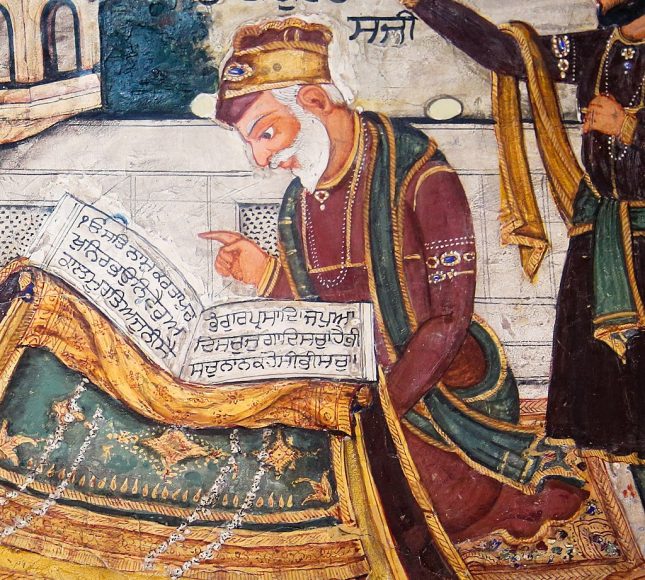KABITTSAVAIYYE, by Bhai Gurdas
who had worked with Guru Arjan on the preparation of the original volume of Sikh scripture, the Guru Granth Sahib, and who is remembered in the Sikh tradition as the first consistent interpreter of the Gurus’ word, is a collection of 675 kabits and savaiyye composed by the poet in Braj. Of his kabits and savaiyye, a total of 556 were known before 1940 when Bhai Vir Singh searched out and published another 119 of them, thereby bringing their total to 675.
However, nine kabits, among the later 119, are almost identical with the other nine published earlier. Some scholars thus exclude these nine and take the total number of these kabits and savaiyye to be 666. It is generally believed that some of the kabits and savaiyye are still untraced. As regards the time and place of these compositions, opinion varies. It is generally believed that a major part of this work was completed after the poet’s more popular work, the Vars, had been written.
The more likely venue was Kashi and Agra, where the Bhai had lived for some time. The conjecture is strengthened by several factors. One, the theme of the poetry belongs to the poet’s maturer years. Second, the language of these compositions is akin to the contemporary religious and literary genius of Kashi and Agra. A pang of separation from the Guru is the running theme of this poetry. Bhai Gurdas was able clearly to comprehend the meanings of the text and then explain them in the simplest vocabulary.
For the Punjabi readers, he has done this in his Vars and for his readers in Kashi and Agra in the kabits and savaiyye. To make his works widely comprehensible, Bhai Gurdas has used similes and metaphors from daily life. In the first section the poet has used kabits and savaiyye in their simplest form. The thrust is in the fourth and final line in which his meaning is communicated very forcefully.
The poetry also symbolizes Bhai Gurdas’s deep love for his Gurus. Bhai Gurdas spent long spells in Agra and Kashi spreading the message of the Gurus, but he always longed for a glimpse of the Guru. Compositions dealing with the poet’s pangs of separation are a fine specimen of his poetic art.
References:
- Kaur Singh, Akali, Taikara Bhai Gurdas, p. de Kahitt Savaiyye. Amritsar, 1929
- Jaggi, Rattan Singh, Bhai Gurdas: fivani Ie Rachna. Patiala, 1974
- Darshan Singh, Bhai Gurdas. Patiala, 1986
Exploring the Profound Kabitts and Savaiyyas of Bhai Gurdas
Bhai Gurdas stands tall as a pioneering literary figure in Sikh tradition—not only for his work in compiling and explaining the Sikh canon but also for his original poetic compositions known as the Kabitts and Savaiyyas. These verses, composed in Braj, reflect a deep spiritual sensitivity and are imbued with themes of love, separation, and profound wisdom.
The Essence of Kabitts and Savaiyyas
In these poetic compositions, every verse is more than a mere arrangement of words—it is a distilled expression of the devotee’s heart. Bhai Gurdas used a mix of short, rhythmic forms (often structured with quatrains where the final line delivers a potent message) to articulate his spiritual experiences. The Kabitts and Savaiyyas speak of both the personal and the cosmic; they capture the soul’s yearning for the divine presence and its deep sense of separation when that presence seems distant.
Key themes in these compositions include:
- Love and Devotion: The verses radiate a profound love for the Guru. Bhai Gurdas was not only a scholar and interpreter of Sikh scripture but also a devoted seeker. His writings convey a tender, almost lyrical attachment to the Gurus. Each Kabitt or Savaiyya is suffused with emotional intensity, offering a window into the intimate relationship between the seeker (the devotee) and the divine teacher.
- Separation and Longing: A recurring motif is the sensation of separation—the bittersweet pain of being apart from the Guru. This separation, however, is not presented as a mere physical distance but as a spiritual and existential condition; it provokes a yearning that ultimately drives one toward reuniting with the divine. Through metaphors drawn from everyday life—such as images of barren landscapes, fleeting shadows, or the ephemeral beauty of a sunset—Bhai Gurdas communicates a universal truth about the human condition: the constant desire to overcome alienation through spiritual union.
- Spiritual Wisdom: Beyond the emotional landscape of love and separation, the Kabitts and Savaiyyas are a repository of spiritual wisdom. Bhai Gurdas succeeded in transforming complex doctrinal truths into verses that were accessible yet deeply philosophical. In his work, the importance of nam simran (meditation on the Name), the nature of God, and the role of the true Guru are expounded upon with clarity and grace. His use of similes, metaphors, and imagery drawn from the mundane lives of common people ensured that these high spiritual concepts resonated with a broad audience. The Context and Impact of These Poems
Bhai Gurdas is often credited as the first consistent interpreter of the Guru’s word, his compositions serving as guides for both the learned and the lay devotee. While his more popular work—the Vaaran—garnered widespread attention, the Kabitts and Savaiyyas hold a special place in the hearts of those who search for nuance in the expression of divine longing.
Living for extended periods in places like Kashi and Agra, Bhai Gurdas absorbed the cultural and literary genius of these cities. This exposure enriched his language, blending folk sensibilities with refined, classical forms. The resulting verses are known for their simplicity of vocabulary and a forcefulness that emerges in the final line of each stanza, where hidden depths of emotion and meaning are succinctly expressed.



